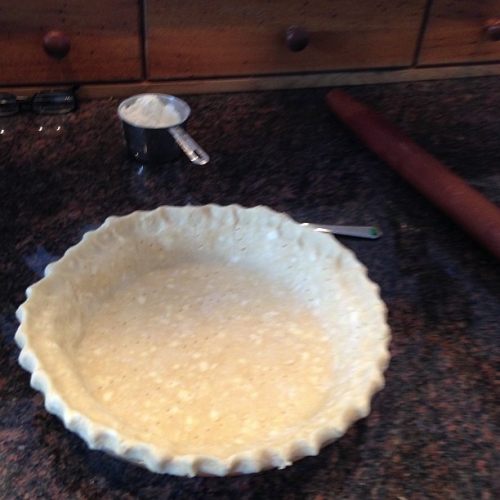
Any time I’ve suggested a tool, a piece of equipment, or a culinary term that’s unfamiliar to you, you can go to Learn to Cook for more information.
Place flour, salt and sugar in the work bowl of a food processor fitted with the steel blade and process to combine and lighten them. Or, combine in a mixing bowl using a whisk. If making a savory pie, whisk herbs or seeds into the dry ingredients now.
Drop diced cold butter and shortening bits into dry ingredients. Pulse machine until mixture resembles coarse meal. If using a hand-held pastry blender, incorporate butter and shortening until mixture reaches the desired consistency.
While machine is running, pour in ice water in a slow steady stream, until the mixture in the bowl just starts to mass together. Stop machine and test several areas by gently pinching a piece of dough with your fingers; it should feel moist, but not wet, and should hold together. Avoid over-processing or the pastry will be tough. If dough seems too dry or mealy, drizzle on a little more water to those dry areas. And be sure to check several areas of the dough before adding more liquid.
Drizzle in ice water and toss gently with a wide blending fork. As each section becomes moistened, gently shove that part to one side of the bowl as you continue to moisten the rest. (See preceding step for judging moistness of dough.)
Dump the dough out on to a large criss-cross of plastic wrap and place the exposed ends of the wrap over the dough. Flatten the dough into a disc and, after wrapping it securely, chill the dough for 1 hour (or up to 2 days) before using. This dough also freezes perfectly for 2 months when wrapped and placed in a labeled heavy-duty freezer bag.
Remove dough from refrigerator and, if very cold, let sit at room temperature for 5 minutes. If using a pastry cloth, lay it out on your work surface and rub some all-purpose flour into the exposed surface. Lay dough on the cloth or a lightly floured work surface or between 2 sheets of waxed paper. Roll out dough 1/8 inch thick and at least 1 inch larger than the pie plate or tart pan.
Roll up pastry loosely on a lightly floured rolling pin and carefully unroll it onto the pie plate. Alternatively, invert the rolled pastry into an empty pie pan and peel off the wax paper. Brush off any excess flour, then turn the overhang of dough underneath itself to reinforce the sides. Crimp the rim decoratively. Lightly dock (prick) dough all over the interior including the sides and cover with plastic wrap or aluminum foil. Refrigerate or freeze for 1 hour before baking.
If using a tart pan, place a shallow baking sheet into the center of the oven (this makes it easier to remove the pan from the oven after baking). Preheat the oven to 400o F. Line the interior of the shell with aluminum foil (shiny side down). Fill foil with dried beans or pie weights and, if the pastry is frozen, bake for 15 minutes (10 minutes, if refrigerated). Carefully lift out foil and weights and lightly prick the interior again. Reduce oven temperature to 375o F and bake 10 minutes more. The crust should appear to be lightly cooked and only just starting to brown. Transfer to a wire rack to cool.
The pastry (whether sweet or savory) can be made and stored in the refrigerator for up to 3 days or wrapped in plastic wrap, then aluminum foil, sealed in a heavy-duty freezer bag and frozen for 2 months. Make sure to label and date the package before freezing. To thaw, place in the refrigerator overnight, keeping the pastry in its original wrapping.
The pastry can be rolled and placed in a pie or tart pan 1 week ahead and kept frozen. Cover gently but efficiently with plastic wrap and slip pan into a jumbo freezer bag. Seal the bag. Do not thaw before pre-baking.